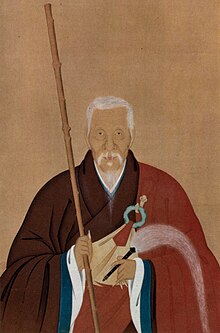Yin-yuan
Yin-Yüan Lung Ch'i ( Chinese 隱 元 隆 琦 , Pinyin Yǐnyuán Lóngqí , Japanese Ingen Ryūki ; * 1592 in Fuzhou , then Fu-ch-in 福清 ; † 1673 in Japan ), was a Chinese Zen monk who in Japan the third important Zen school, which Ōbaku-shū founded.
Life path
Was born Lung Ch'i ( 隆琦 in the family Lin ( 林 )). At that time still under the rule of the Ming Dynasty . His father disappeared without a trace. While looking for him, Yin- Yuan entered a monastery in Nanhai . Yin-yuan is his religious name. At the age of 29 he became a student of Chien-yuan (Japanese: Kangen Zenji ) in Wan-fu-ssu ( 万 福寺 ) on Mount Huang-po ( 黄 檗 山 ) in the Chinese province of Fujian . After the death of his master, he first became a disciple of Fei-yin (Japanese: Hiin ), then ruler of the temple. He earned a reputation as a teacher.
In Japan
After several invitations from the Chinese monk Itsunen Shōyū (Chin. I-jan ), who lived in Nagasaki , and his lay patrons, he went to Japan at an age of 63 in 1654, which was already high for the time. With him came 20 monks and 10 artisans who probably fled the political chaos of the time. First he resided in Kofuku-ji , then in Sofuku-ji . His reputation as a teacher had preceded him, so that soon a number of students began to gather.
After an audience with the Shogun Tokugawa Ietsuna , he was allowed by Bakufu in 1658 to restore a temple of the branch school Genjū-ha ( 住 派 派 ) of the Rinzai-shū in Uji near Kyoto . For this, the temple received a donation from land and 4000 koku . This later became the main temple of the Ōbaku-shū: the Mampuku-ji , the basic structure of which was completed by 1662. It is named after the model of its Chinese home temple, as is the mountain Ōbaku-san, which is written with the same characters as the Huang-po. Mu-an followed him as abbot.
Yin-Yüan's calligraphies are characterized by a powerful style with strong curves. He is one of the three artists known as Ōbaku no Sampitsu .
Posthumously he was given the name Daikō ōshō kokushi -
Yin-Yüan is always referred to as Ingen in Japan , not to be confused with other monks of the same name, whose names are written with other Kanji , but read the same way, e.g. B. the son of Taira Motohiras 院 元 (954-1028) or the abbot of Kenchō-ji 印 元 (1295-1374).
Works
Wholly or partially attributable to him are:
- Fushōkokushi Kōroku
- Ōbaku Goroku ( 黄 檗 語録 )
- Ōbukusanshi ( 黄 檗 山 志 )
- Ingen Hōgo ( 隱 元 法語 )
Literature and Sources
- Helen Baroni: Obaku Zen. The Emergence of the Third Sect of Zen in Tokugawa Japan . University of Hawai'i Press, Honolulu 2000, ISBN 0-8248-2195-5
- Martin Ramming (ed.): Japan manual . Berlin 1941, p. 243
- Stephen Addiss : Obaku: Zen Paintings and Calligraphy . 1978
Individual evidence
- ↑ Overview of works see: Eike Moog: Biobibliographisches Handbuch Japanese and Chinese, Buddhist and Shintôist priests, monks and nuns and artists associated with them with importance for writing and painting . Galerie Eike Moog, Cologne 1995, ISBN 3-921981-1000-1 , p. 175
- ↑ Berend Wispelwey (Ed.): Japanese Biographical Archive . Munich 2007, ISBN 3-598-34014-1 , Fiche 101
| personal data | |
|---|---|
| SURNAME | Yin-yuan |
| ALTERNATIVE NAMES | Yin-Yuan Lung Ch'i; Lin (maiden name); 林 (maiden name); 隱 元 隆 琦 (religious name, Chinese); Ingen Ryūki (Japanese); Ingen Zenji (Japanese); Yinyuan Longqi (pinyin); Daikō ōshō kokushi (posthumous) |
| BRIEF DESCRIPTION | chinese zen monk |
| DATE OF BIRTH | 1592 |
| PLACE OF BIRTH | Fuzhou , China |
| DATE OF DEATH | 1673 |
| Place of death | Japan |
